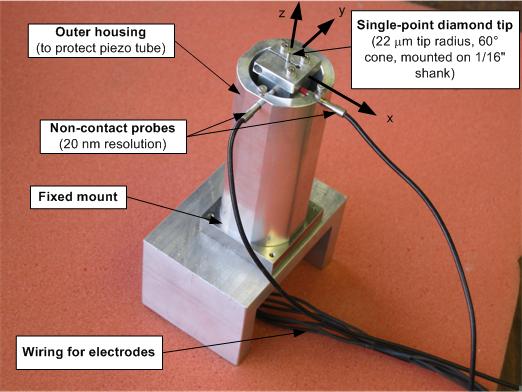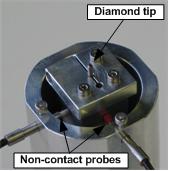
Teaching
Resources
A PZT Driven Micromachining Tool Based On Single-Point Tool Tip Geometry
Sumet Heamawatanachai, Ph.D. candidate
This novel micromilling technology is based on single-point diamond tip milling which can be used to machine microsized features into a wide range of materials ranging from polymers, through metals to glass. The unique characteristic of this technology is that the cutting velocity is not created by rotating the tool tip about its axis of rotation. Instead, the cutting motion is generated by actuating the tool tip on a recirculating, microscopic trajectory at high frequencies. This allows a standard 3-axis setup to generate the macroscopic motion required for the tool path while at the microscopic level, the cutting motion and the tool path are being generated by the tool itself. As a result, truly three-dimensional part geometries at the micron level with exceptional surface finish and part accuracy can be created.
The microscopic motion of the tool tip is achieved by a 75 mm long piezo tube scanner (PZT) made from EC-63 ceramics with an outer diameter of 15.4 mm and a wall thickness of 0.79 mm with four external electrodes. By energizing the four electrodes with time-varying voltages that range between 0 and -1000 V, periodic bending of the free end of the tube is achieved. If the voltages are sinusoidal with a phase lag of 90 degrees between adjacent electrodes, the resulting periodic bending creates a planar, orbiting motion with a maximum radius of 35 microns that is perpendicular to the PZT’s axis. Since the orbiting motion is planar, the machined surface is flat, making this cutting mode the equivalent of a miniaturized flycutter, whose tool tip offset from the axis of rotation can be varied during cutting simply by varying the amplitude of the driving voltages.
Actuating the tool tip with a PZT has another exciting possibility. Overlaying the sinusoidal driving voltages (primary voltage) with a secondary, time-varying voltage can be used to periodically change the length of tube in addition to the bending. This creates a three-dimensional tool path of the tool tip that can take on a number of very interesting trajectories. For example, if the secondary voltage has the same frequency as the primary voltage and is applied to all four electrodes, the periodic change in tube length creates a planar, orbiting motion that is no longer perpendicular to the tube’s axis but is tilted instead. This mode allows the machining of tapered surfaces which in conventional micromilling would require the use of a tapered endmill or the tilting of either the tool or the workpiece. Varying the frequency and phase of the secondary voltage creates even more complicated tool trajectories that can be used to machine free-form surfaces at the micron level.
Machining examples - stainless steel
Publications:
S. Heamawatanachai, E. Bamberg (in press). Design and characterization of a PZT driven micromachining tool based on single-point tool tip geometry. Precision Engineering. DOI:10.1016/j.precisioneng.2008.10.006. Published online November 12, 2008.
E. Bamberg, S. Heamawatanachai (2007). A novel micromilling technology based on single-point tip geometries. In: Proc. 2007 ASPE Conf., Dallas, TX, October 14-19, 2007, pp. 28-31.



